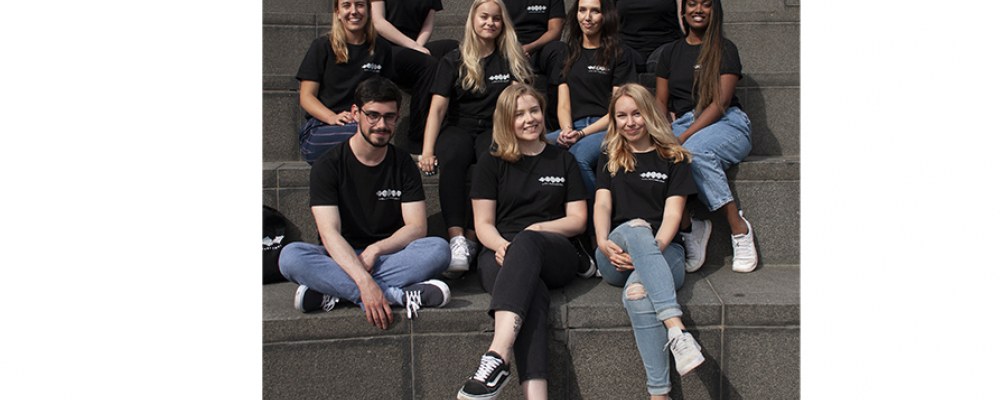
Aalto-Helsinki iGEM team is exploring the gut-brain axis
A team from Aalto University and University of Helsinki is on their way to world's largest synthetic biology competition, iGEM. Their project focuses on the gut-brain axis and mental health.
We are the Aalto-Helsinki 2021 iGEM team, participating in the world’s largest synthetic biology competition, iGEM (International Genetically Engineered Machine). Our team consists of 10 highly motivated students from the two top Finnish universities, Aalto University and the University of Helsinki. Our team is very diverse, but we share the same ambition to change the world with synthetic biology.
Our mission is to design and create a synthetic biology project from scratch, to make the world a better place.
For those who are not familiar with synthetic biology, it means engineering organisms to have new abilities, to create new types of solutions. These solutions can then be used to solve problems in fields like medicine, manufacturing and agriculture. Our mission is to design and create a synthetic biology project from scratch, to make the world a better place.
The journey of Aalto-Helsinki began all the way in 2014, being the first ever Finnish iGEM team, and there has been a variety of different synthetic biology projects during all these 8 years. For example in 2014, team Aalto-Helsinki created bacteria with three-channel switches, controlled by the intensity of light.
Each year a new Aalto-Helsinki team creates something totally unique to compete against other top universities in the world. Although iGEM is a competition, the journey is about learning new skills, creativity and students challenging themselves to do things that haven’t been done before.
Our team has expertise from various fields, such as microbiology, genetics, molecular biology, engineering, bioinformatics and even psychology. Our team was assembled in early February 2021, and we immediately started brainstorming for our project idea.
We dived into the research of the gut-brain axis and its connections to mental health.
At first, we had many very different ideas, all the way from designing heat-resistant insulin to coral-reef-friendly sunscreen. However, one topic rose above others. We wanted to focus on designing something to help preventative mental health care and help with early risk assessment. We also wanted to approach this from a new perspective, and soon we dived into the research of the gut-brain axis and its connections to mental health.
The gut-brain axis is the link between the enteric nervous system and the central nervous system. For example, the gut microbiota produces a lot of compounds that our bodies can’t produce. Some of those compounds are assumed to affect the brain’s neurochemistry. However, we realised that there’s too little information on how the gut-brain axis actually works, so it’s no use creating a diagnostic tool if we can’t say for sure what happens in the gut.
To tackle this problem, we decided to create an ingestible electronic biosensor to detect concentrations of compounds produced by the gut microbiota metabolism. Since there’s not enough knowledge on the connections between these compounds and the brain, we are targeting the sensor to detect compounds associated with mental health. Our design, Gutlux, is a research tool to further investigate the gut-brain axis.
Luckily, we aren’t alone on this journey of iGEM. We have met a lot of experts from various fields during the ideation process to help us shape our project idea. Now that we have moved on to the practical part of the project, we also have help from experts from both the School of Chemical Engineering at Aalto University and the University of Helsinki to help us execute the proof-of-concept experiments of our project.
Right now, in the middle of summer, we have been working full-time for over a month already in the laboratory facilities provided by Aalto University. During this time, we have started the practical laboratory work to build our biological detection mechanism, as well as modeling the mechanism computationally and building an electronic prototype of our device.
You don’t have to know everything in advance, you just have to be eager to learn it.
In addition to all the scientific work, a big part of iGEM is community outreach. Our team is ambitiously working towards better scientific outreach - we are hosting a podcast, writing a blog and updating educational material on our social media platforms.
We’ll keep working for our ambitious goals for the whole summer and continue the grind all the way until it’s time for the Giant Jamboree, the final competition of iGEM, where all the teams from all over the world assemble to present their projects. Depending on the ongoing Covid-19 situation, the Giant Jamboree is either held live in Paris or remotely. We are keeping our fingers crossed for Paris!
On our way there, we definitely have a lot to learn. One of the most important lessons that we have already learned is that you don’t have to know everything in advance, you just have to be eager to learn it.
The iGEM final will be held later this year, dates are to be confirmed. Read more here.
Follow Aalto-Helsinki team's journey here. TEK is one of the team's sponsors.